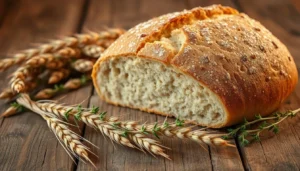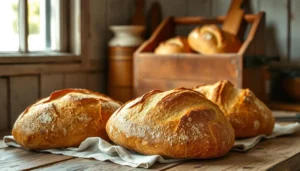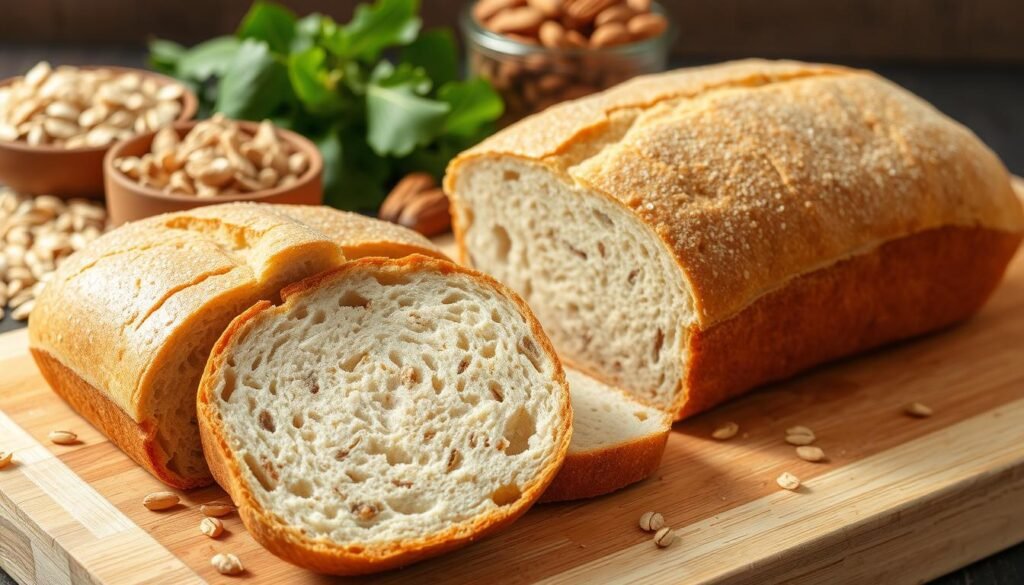There’s nothing quite like the smell of freshly baked bread in your home. Homemade wheat bread lets you enjoy a great taste and health benefits. You can control the ingredients, making it a nutritious choice without artificial additives.
This article will show you the benefits of whole wheat bread. You’ll find different recipes and tips to make delicious loaves at home. Enjoy the wholesome goodness of wheat breads , knowing it’s full of essential nutrients!
Key Takeaways
- Homemade wheat bread is a fresher alternative to store-bought varieties.
- Control your ingredients for a healthier option free from additives.
- Whole wheat bread offers numerous nutritional benefits.
- Baking at home allows for customization based on your tastes.
- Enjoy essential vitamins and minerals found in whole grains.
What is Wheat Bread and Its Benefits?
Wheat bread is a healthier choice than white bread, thanks to its nutritional value. Knowing the difference between whole grain and refined wheat bread helps you make better food choices. These choices can improve your health.
Nutritional Value of Wheat Bread
Whole grain wheat bread is packed with nutrients. It’s made from the whole wheat kernel, keeping more nutrients than refined bread. It’s rich in vitamins, minerals, and fiber.
Whole grain wheat bread contains B vitamins, magnesium, and phosphorus. These nutrients are key for a balanced diet.
Health Benefits of Choosing Wheat Over White
Choosing whole grain wheat bread over refined has many health perks. It’s high in fiber, which is good for digestion and blood sugar control. It also helps lower cholesterol and heart disease risk.
it offers better nutrition and health than white bread. It’s a smarter choice for your diet.
Whole Grain vs. Refined Wheat Bread
It’s important to know the difference between whole grain and refined one. Whole grain bread keeps the kernel’s natural goodness. Refined bread loses many nutrients and fiber during processing.
Switching to whole grain wheat bread gives you the most health benefits. It’s a better choice for your diet.
How to Make Homemade Wheat Bread
Making homemade one is all about the right ingredients and baking steps. This recipe will help you make a delicious loaf with a nutty flavor and crispy crust. Get your ingredients ready for a step-by-step baking guide.
Necessary Ingredients for Success
The key to great homemade wheat bread is its ingredients. Here’s what you need for your bread-making journey:
- 100% whole wheat flour
- Warm water (between 105°F and 115°F)
- Honey or maple syrup
- Olive oil
- Active dry yeast
- Salt
Step-by-Step Baking Process
Start by activating the yeast. Mix warm water with honey, then add yeast on top and wait for it to get frothy. In another bowl, mix the wheat flour and salt. Add the yeast mixture and olive oil to the dry ingredients. Knead the dough for 10 minutes until it’s smooth.
Let it rise in a warm place until it doubles, about 1 hour. Punch down the dough, shape it into a loaf, and let it rise again. Bake until it’s golden brown.
Baking Tips for Perfect Texture
For the perfect loaf, follow these tips:
- Keep the yeast at the right temperature for rising.
- Avoid over-kneading to prevent tough bread.
- Watch the rising time to avoid under or over-rising.

Popular Wheat Bread Recipes to Try
Exploring wheat bread opens up a world of tasty options. Each recipe brings its own flavors and textures. They can make your meals better or be a great snack on their own. Here are some top picks that will make your taste buds happy.
Classic Whole Wheat Bread Recipe
The classic wheat bread recipe is a must-try. It’s a healthy and tasty loaf. Its fluffy texture and nutty taste are perfect for sandwiches or toast at breakfast.
It’s made with simple ingredients like whole wheat flour, water, yeast, and salt. This combination creates a bread that’s great for any time.
Honey Wheat Bread for a Touch of Sweetness
The honey wheat bread recipe adds a sweet twist. Honey makes it moist and soft. It’s great with peanut butter, fruit spreads, or just on its own.
This recipe shows how honey can make bread even better. It’s a hit with those who love a little sweetness.
Spiced Wheat Bread with Nutmeg and Cinnamon
Spiced one warms up your kitchen with amazing smells. It’s made with nutmeg and cinnamon, making it cozy and flavorful. These spices blend well, adding a warm touch perfect for cold months.
You can also add nuts or dried fruit for more texture and taste. It’s a great way to spice up your bread.
Variations of Wheat Bread Around the World
it is loved worldwide for its many flavors and textures. It’s a key ingredient in many cuisines. Let’s explore some famous types, like Indian roti, Middle Eastern pita, and Italian farina bread.
Indian Whole Wheat Roti
The Indian roti, also known as chapati, is made from whole wheat flour. It’s soft and flat, great with curries and veggies. You can find many variations, each with its own twist.
Middle Eastern Pita Bread
Middle Eastern pita bread is known for its pocket. It’s perfect for filling with meats, veggies, or hummus. Its texture is just right for Mediterranean dishes.
Italian Farina Bread
Italian farina bread is special because of its durum wheat semolina. It has a crunchy outside and a soft inside. It’s great for sandwiches or with soups, adding flavor to any meal.
| Type of Bread | Main Ingredients | Key Characteristics | Common Pairings |
|---|---|---|---|
| Indian Whole Wheat Roti | Whole wheat flour, water | Unleavened, soft | Curry, vegetables |
| Middle Eastern Pita Bread | White flour, yeast | Pocket formation, chewy | Stuffed with meats, hummus |
| Italian Farina Bread | Durum wheat, water, yeast | Crusty exterior, chewy interior | Sandwiches, soups |
Common Mistakes to Avoid When Baking
When baking homemade wheat bread, avoiding common mistakes is key. Knowing pitfalls like using wrong flour, over-kneading, and wrong rising times can make a big difference. Follow these tips for a successful baking experience.
Using the Wrong Flour Type
Choosing the right flour is crucial for your wheat bread’s texture. Whole wheat flour is best for certain recipes, while all-purpose flour can make bread denser. Knowing the differences in flour types can greatly affect your baking.
Over-kneading the Dough
Kneading is important for gluten development, but too much can make bread tough. Watch the dough’s texture and elasticity. Good kneading tips can help you get the right balance for a soft, perfect loaf.
Misestimating Rising Times
Getting rising times right is key for the bread’s structure. Wrong rising times can make dough under- or over-proofed, affecting texture and taste. Use a timer and watch environmental conditions to get it right, ensuring your loaves rise perfectly.
Best Practices for Storing it
To keep your homemade wheat bread fresh, you need good storage tips. Using the right methods can make your bread last longer. This way, you can enjoy its taste for weeks. Here are some tips for short-term and long-term storage, and how to tell if bread has gone bad.
Short-Term Storage Solutions
For eating it soon, store itin a good spot. Use a bread bin or airtight container at room temperature. This keeps bread fresh for 3 to 4 days, so it stays soft and tasty.
Long-Term Preservation Methods
For longer storage, freezing is best. Wrap the bread tightly in plastic wrap or foil before freezing. Freezing can keep your wheat bread fresh for up to two months, without losing its quality.
Signs Bread Has Gone Bad
Keeping your bread fresh means knowing when it’s bad. Look out for these signs:
- Mold growth on the surface.
- A sour or unpleasant smell.
- A hard or crusty texture that indicates excessive staleness.

By following these storage tips and knowing when bread is bad, you can make your homemade one last longer. This way, you can enjoy its goodness in every bite.
How to Use it in Meals
Wheat bread is great for many meals. Its nutty taste makes it perfect for sandwiches and breakfast. With some creative ideas, you can make your meals better using this healthy bread.
Delicious Sandwich Ideas
it is a great base for sandwiches. Try these tasty combinations:
- Turkey, avocado, and spinach for a healthy twist
- Hummus, roasted vegetables, and feta for a Mediterranean flair
- Peanut butter, banana, and honey for a sweet treat
These ideas not only fill you up but also add nutrients to your diet.
in Toast and Breakfast Dishes
Start your day with wheat bread. Top toast with:
- Avocado and poached eggs for a filling start
- Cinnamon and maple syrup for a sweet indulgence
- Nut butter and fresh fruit for a protein-packed option
Adding wheat bread to breakfast boosts your fiber and keeps you energized.
Creative Ways to Use Leftover Bread
Don’t waste leftover wheat bread. Try these creative uses:
- Create homemade croutons for soups and salads
- Make breadcrumbs for meat dishes or baking
- Prepare a delicious French toast with a touch of vanilla and cinnamon
Wheat Bread and Dietary Considerations
Adding wheat bread to your meals requires thinking about your diet. It’s key to know how it fits into a balanced diet and meets your dietary needs. Understanding how it works with different diets helps you enjoy it more.
Gluten Sensitivity and Wheat Bread
People with gluten sensitivity face big challenges with the traditional one . It’s important to look for gluten-free options. Breads made with almond flour or rice flour can be good substitutes. Those with gluten sensitivity need to be careful about what bread they eat to avoid bad reactions.
Options for Vegan and Vegetarian Diets
it is a great for vegan and vegetarian diets. Many recipes use only plant-based ingredients. This makes it easy to add to your meals. Vegan bread options, like those made from whole grains and seeds, are tasty and nutritious.
in a Balanced Diet
Wheat bread can be a good part of a balanced diet if eaten in moderation. It has fiber and vitamins from whole grains. Adding healthy toppings like vegetable spreads or avocado makes it even better. Knowing how much to eat helps you stay on track with your diet.

| Dietary Considerations | Details |
|---|---|
| Gluten Sensitivity | Seek gluten-free alternatives to traditional wheat bread. |
| Vegan Options | Choose bread made with plant-based ingredients, avoiding dairy and eggs. |
| Balanced Diet | Integrate wheat bread with a variety of nutritious toppings for enhanced benefits. |
Frequently Asked Questions About Wheat Bread
Exploring homemade wheat bread often raises several questions. Knowing these can improve your baking skills and lead to better results. Freezing homemade bread is a great way to keep it fresh longer. Wrap it well in plastic wrap or foil, then put it in a freezer bag.
Many people wonder about the health benefits of whole wheat. Whole grain products like whole wheat bread are full of fiber and nutrients. They are better for you than white bread, helping with diet and weight management.
Knowing when your bread is done is key for a perfect loaf. Tap the bottom of the loaf; if it sounds hollow, it’s done. Following these tips will make you more confident in the kitchen and ensure delicious, nutritious bread every time.
FAQ
Can I Freeze Homemade Wheat Bread?
What Makes Whole Wheat Bread Healthier?
How to Tell When Bread is Fully Baked?
Is Homemade Wheat Bread Better Than Store-Bought?
Can I Add Seeds or Dried Fruits to My Wheat Bread?
How Long Does Homemade Wheat Bread Last?
Are There Gluten-Free Alternatives for it?
How Can I Use Leftover of it?
check this recipe out for more
